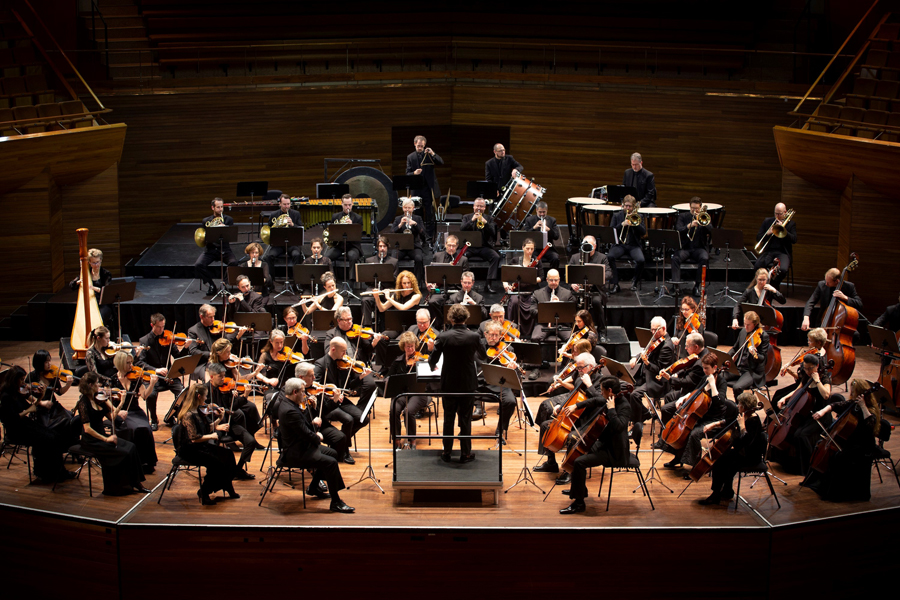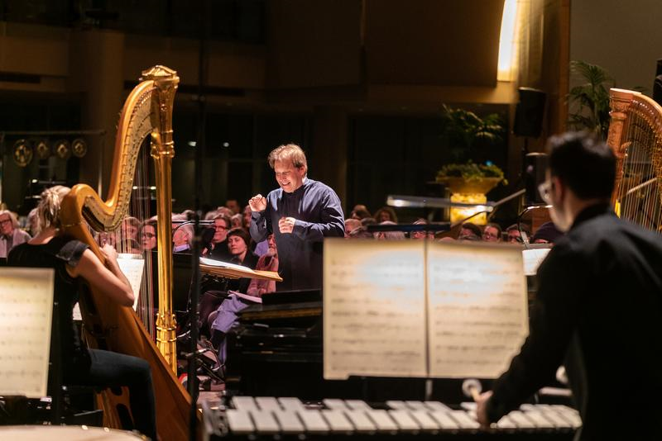|
Conductor and
Harpist: How to Be Good Partners
by Joyce Rice

Conductor
Hamish McKeich and
harpist
Carolyn Mills
(Thanks
to
New
Zealand
Symphony Orchestra )
Harpists new to the orchestral setting plus conductors unfamiliar
with harps or their players can make for a rocky boat ride. What can be done
to calm the waters?
I’m
sure there are harpists who have had lessons and decide or are asked to join
a community orchestra. It can be a wonderful experience getting to know a
large variety of orchestral works and becoming acquainted with other
music-lovers. But most of those other instrumentalists have at least been in
a school band or orchestra and learned how to follow the baton and what a
4/4 or 3/4 beat looks like, whereas many harp students have only been
working on solo repertoire. Any harpist in that position should try to learn
conducting patterns, maybe sit in (without harp) at a school or college
rehearsal, counting and watching. Harp ensembles have also been a great boon
in learning to follow the baton.
What
else can harpists at any level do to have a smooth connection with the
conductor?
-
Work on good rhythm and a full tone so you can be heard.
-
Ask
to get your parts as soon as possible. If you can, listen to recordings
of the upcoming pieces while watching your score to become a little
familiar with the work and your part in it.
-
Learn your part well before the first rehearsal. You’ll probably have no
section partner to cover for you.
-
Mark your parts with pedal changes and put pedal charts at all rehearsal
letters or numbers so you can be ready to start quickly at any place. If
there are a lot of changes in a particular place, alert the conductor
before rehearsal or during intermission so he’ll know to check with you
before starting.
-
Patti Warden suggests that, alternatively, you make a photocopy of the
part before you add in your markings, then add them to the photocopy.
Other harpists might prefer different markings, and if the part is a
rental, there are charges for erasing any markings. Keep your
photocopies of parts in a file for yourself.
-
Keep your harp in good regulation – every two years at least. I was in
my 30s before I heard of regulation – bet I could have qualified for
that “harpists are either tuning or playing out of tune” quip.
-
Arrive at the hall at least 45 minutes early to tune. Customarily,
orchestras tune to A=440, but if possible, ask, as there may be a reason
for a different tuning. If you need to tune otherwise, check it again a
couple of times before the rehearsal starts.
-
(Some conductors might not know about pedals, tuning, strings, etc.,
thinking a harp works like a piano. Elizabeth Volpe-Bligh tells about
one who asked her for ‘more pedal’! What did he want – more sustain?
Louder? Lia Lonnert in “Surrounded by Sound” mentions a conductor who
“asked me to ‘tune A-flat, then A-natural, then A-sharp. Oh, it’s not
good, make it a little bit higher or a little bit lower.’ She told him,
‘It can be this way or that way.’ ”).
-
Many harpists find that tuning in Cb, with all the pedals up and the
discs disengaged, gets a better result. You might want to check
super-exposed places with their correct pedals, though, to be sure those
are in tune.
-
Are there a lot
of chords in your part?
You might want to
ask the conductor if s/he wants wide or tightly rolled chords. When
should you play them – start on the beat or end on the beat?
-
Don’t read or
check your phone during tacet parts. Follow the conductor,
counting measures until your next entrance, and prepare your pedals.
Julia Kay Jamieson says, “I have found that the best thing for a good
relationship with conductors is to watch them like a hawk even during
rests - for me it is like relationship building. I get a sense of their
style and personality and skill and how they work with the orchestra.
If they see you looking at them even during a rest they will learn that
you are very present and attentive, which is important. With eye contact
they can learn if you are confident and ready to go or worried about an
entrance and so need a good cue, and you can learn if they are confident
or if they have their hands full and you shouldn't expect any
attention.”
-
Don’t chat when the conductor’s talking. His remarks may not apply to
you but any talking is disruptive to those around you, and you can learn
a lot about the piece by listening.
-
If the conductor
criticizes you, smile and say “OK.” If you disagree, hash it out later.
Like most people, conductors don’t like to be challenged in front of
everyone.
-
If asked to do
something impossible, improvise. John Carrington says,
“I did have a
conductor ask if my harmonic could be ‘more pdlt’ ! I didn’t want
to embarrass him in front of the orchestra [because harmonics are played
in the middle of the string, not près de la table
or next to the soundboard] so I just played the harmonic and with my
other hand “ghosted” the octave above down near the board to blend the
two sounds. He thought it was perfect.”
-
If there seems to
be an error in your part or you’re confused by something, ask the
conductor for help after the rehearsal.
-
Learn
to be adaptable. I once played a Nutcracker run of a dozen or so performances
and the conductor’s tempos were markedly different each time.
-
What you hear in
the orchestra may not match what you’ve heard in a recording. Once my
Harp II partner (and friend) wasn’t staying with the conductor. “Hey,” I
said, “follow the beat!” “But he’s doing it at a different tempo from
the record I listened to,” he complained….

Conductor
Ludovic Morlot, recently retired from the Seattle Symphony, and
harpist Valerie Muzzolini
(Thanks
to
Seattle Symphony / James
Holt )
What
can the conductor do to work well with the harpist?
-
Understand that a harpist may not be as experienced in orchestral
playing as other instrumentalists, especially at a community orchestra
level. Feel lucky to have a harpist. Being kind and helpful will
reap more rewards than being what one harpist calls “a bully”.
-
If
a school conductor with a harpist, make friends with the harp teacher
who can edit parts to fit the student’s ability level.
-
Make
the harp part available as early as possible. It can be difficult for
harpists to sight-read parts at the first rehearsal because pedal
changes and pedal charts need to be written in. Sometimes fingering,
too, to make the part playable. (It’s not unusual for a harp part to
resemble more a piano part but harpists play with eight fingers -no
pinkies - and pianists with ten, so adjustments are often necessary.)
-
Choose a good spot to place the harp. For years I was put behind the
first violins, so as not to be in the way of other players, I guess, but
that meant the sound went toward the conductor rather than out to the
audience. Karen Beth Atz, the Madison Symphony Orchestra's principal
harpist, says, “Sitting beside the percussion section against the back
wall… is an ideal spot because the wall helps bounce the sound out.”
Valerie Muzzolini of the Seattle Symphony usually sits in front of the
percussion at about 10:30 or 11:00 o’clock so her harp is facing toward
the audience.
-
At
rehearsals, give enough time for the harpist to change pedals, if
necessary.
-
A
very clear beat will help everyone, not just the harpist, especially in
music with lots of meter changes. Be aware that the harpists’ eyes move
in a triangle. They must look frequently to the right at the strings,
then to the left to the music, then forward to you, whereas most other
players don’t need to look at their instruments and have both their
music and you in front of them. Also, sometimes the harpists must turn
completely away from you to see the uppermost strings.
(When I
was 21 and a recent college graduate, I took a junior high teaching job
several states away and was glad to hear that there was a community
orchestra nearby. In the first rehearsal, though, I was having trouble
following the conductor. “Harp, you’re not with me!” he finally called out.
“I’m sorry but I’m not seeing your downbeat.” “Then maybe you shouldn’t be
playing in this orchestra!” he retorted. I never went back – it's his loss,
I grumbled to myself - but several orchestra members thanked me. “We can’t
see the downbeat, either,” they said.)
One harpist who shall remain
unnamed says, “My most unpleasant types of interactions with conductors are
when they anticipate a problem before it happens, maybe because they are
inexperienced or because they have worked with a less experienced harpist in
the past. This plays out either by getting some sort of talking-to before
something even happens (which is baffling, embarrassing, and anxiety
inducing), or by getting a cue that is overdone: extra motions, subdivided
to death, etc. In the case of the overdone cue, when it is out of character
from the rest of what they are doing it looks like there is a problem and so
it is harder to just play normally. So a conductor anticipates a problem and
then creates it... I would hope that conductors and harpists both spend some
time getting to know each other as individuals, not assuming anything but
instead observing a lot.”
Last
words
-
Elizabeth
Volpe-Bligh says,
“I've always had excellent relationships with the conductors I've worked
with. Maybe it's because I watch the baton, learn my parts before the
first rehearsal, listen carefully to the rest of the orchestra, and get
there early enough to tune and warm up.
-
Lia
Lonnert quotes Natalia Shameyeva thus: “You know in orchestra we had
very funny rules [about] how to behave with the conductor. The first
rule is that the conductor is always right. The second: If the conductor
is not right, see the first rule.”
-
Lonnert quotes Anna Levina: ‘I never regret my choice of playing
orchestra. But it all depends on the conductor’.
Sources:
Karen Beth Atz in
Harp, Piano and Organ Players are the Orchestra’s Loners by Sandy Tabachnik at https://isthmus.com/music/organ-harp-and-piano-players-are-the-orchestras-loners/.
Lia Lonnert: Surrounded
by Sound: Experienced Orchestral Harpists ’Professional Knowledge and
Learning. Printed in Sweden by Media-Tryck, Lund University Lund 2015.
Thanks to:
John Carrington, Seattle,
WA
Susi Hussong,
Seattle WA
Julia Kay Jamieson,
Champaign, IL
Elizabeth Volpe-Bligh, Vancouver,
British Columbia, Canada
Patti Warden, Seattle
WA
|
















